Where Heaven is Close and the Emperor is far Away: Tea Technique Research Trip 2025 – Yiwu, Yunnan
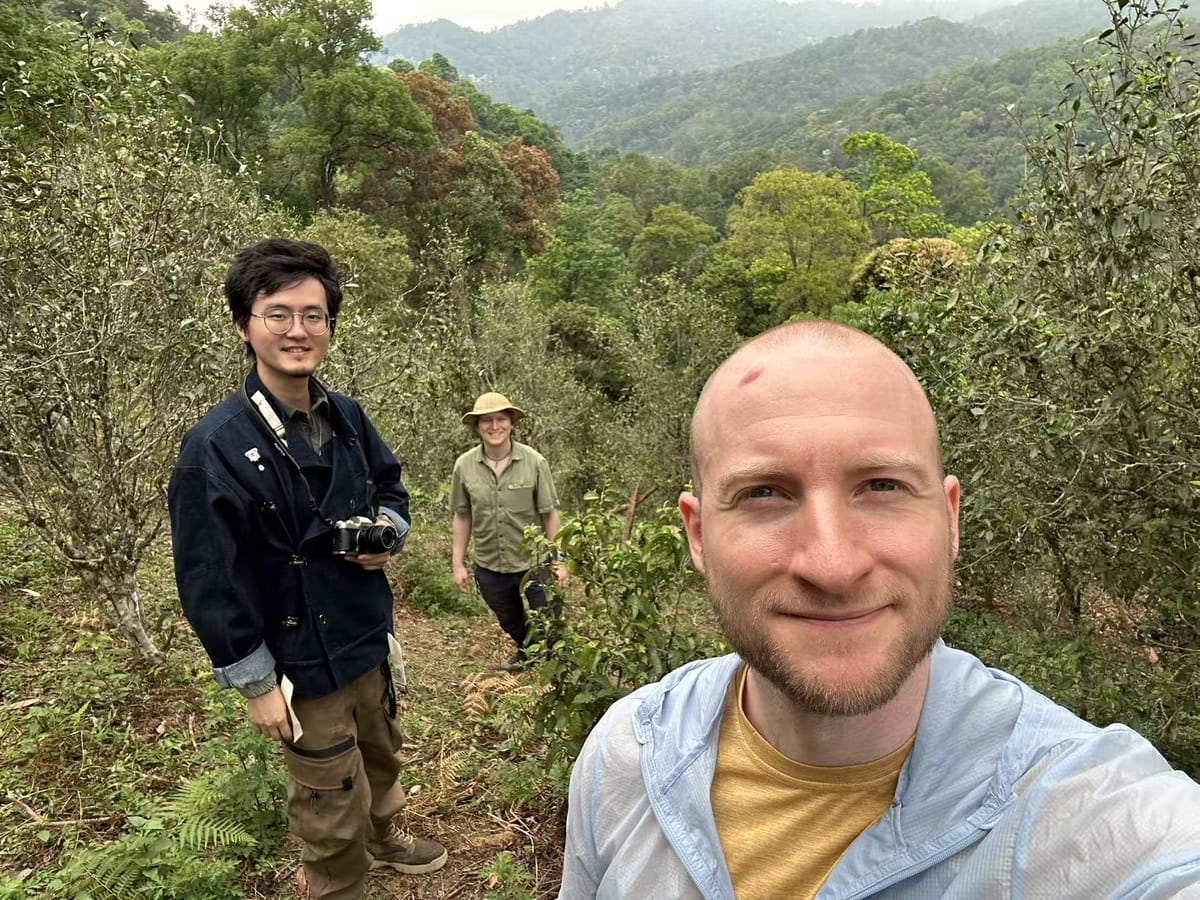
Listen to the Tea Technique Editorial Conversation about this Trip Report:
Yunnan was the south western frontier of imperial China, populated by sinofied tribes, the gateway to Southeast Asia and India, the nexus of the southern silk road and tea horse trail. Yunnan is still a tribal land, far from the imperial heartland of China, where heaven is close and the emperor is far away.
This year’s Tea Technique 2025 Research Trip to Yiwu brought us closer to that proverbial heaven. A place where even much of the village tea is gushu (古树, “ancient tree”) grown without trimming or pesticides, where wild birds and poisonous snakes greet your morning walk, where tea makers eat the leaves off the tree and identify the garden by taste.
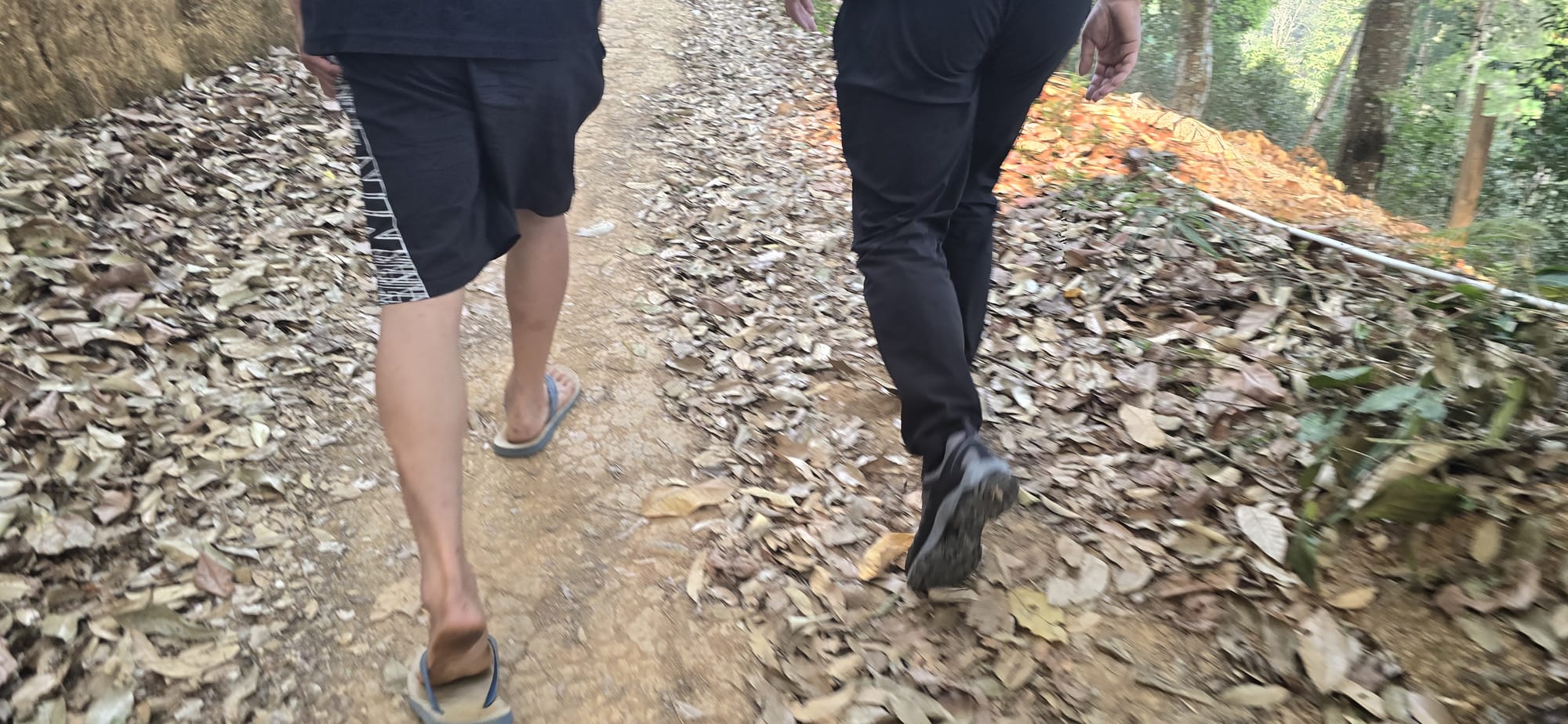
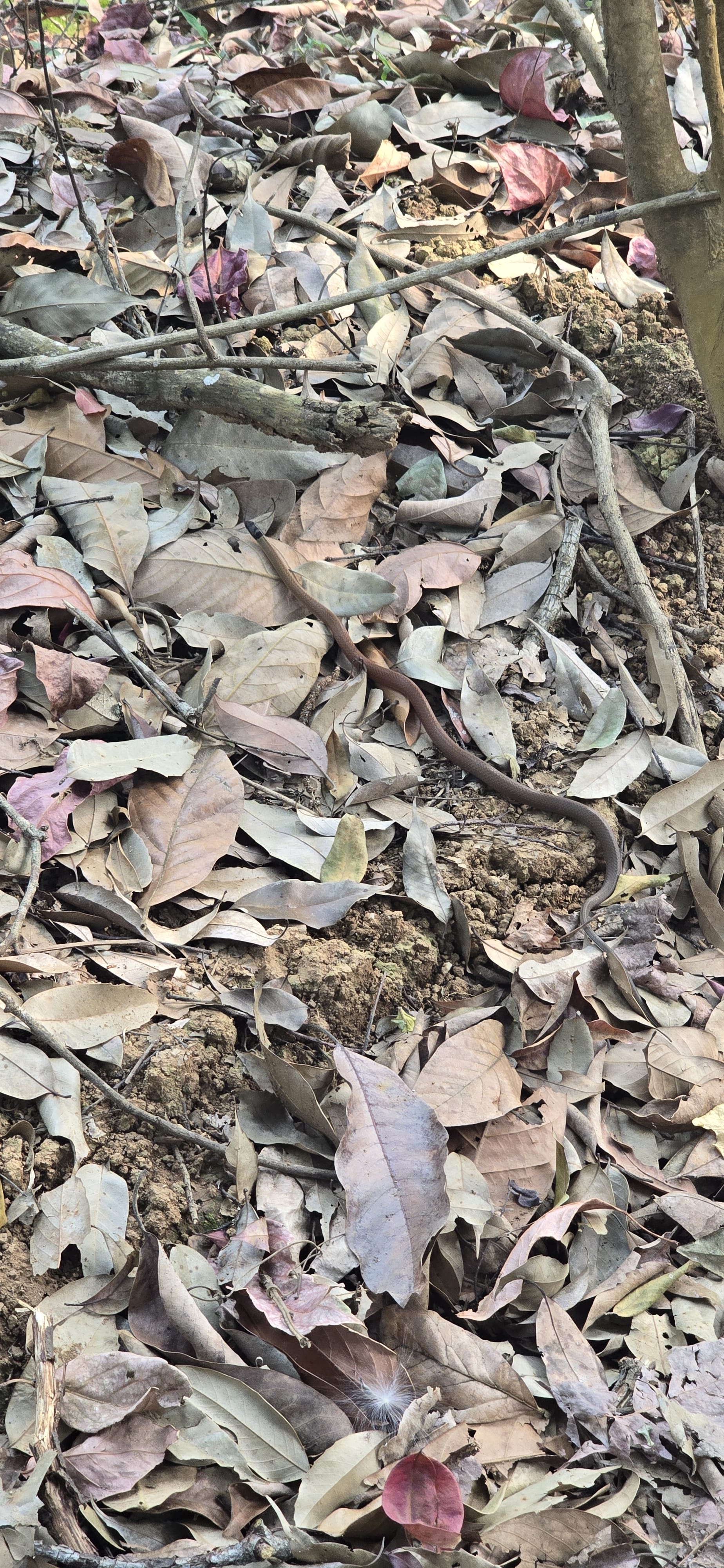
The locals wear sandals even as snakes slither by on our morning walk into the gardens.
The remoteness and well-kept nature of Yiwu is hard to overstate. More than 1,000 acres of old grove “gushu” gardens exist in Yiwu, such that gushu tea is merely the starting place in the local rankings. Nearly all small tree (小树, xiaoshu) and plantation tea is rejected out of hand, with exceptions for family plots planted for weddings or the birth of a child, or the very few plantation-style gardens destined for specific styles of processing. Gushu tea is sub-divided further into “village tea” (easily accessible old trees near the village), “forest tea” (deeper into the forest, in a more natural environment), “large” gushu trees (the big ones…), and “gaogan” (高杆, “tall trees”, which are tall, though usually not the large circumference trunk trees that make for great photos). The preference is almost always for forest tea over village tea, and tall tree over big tree.
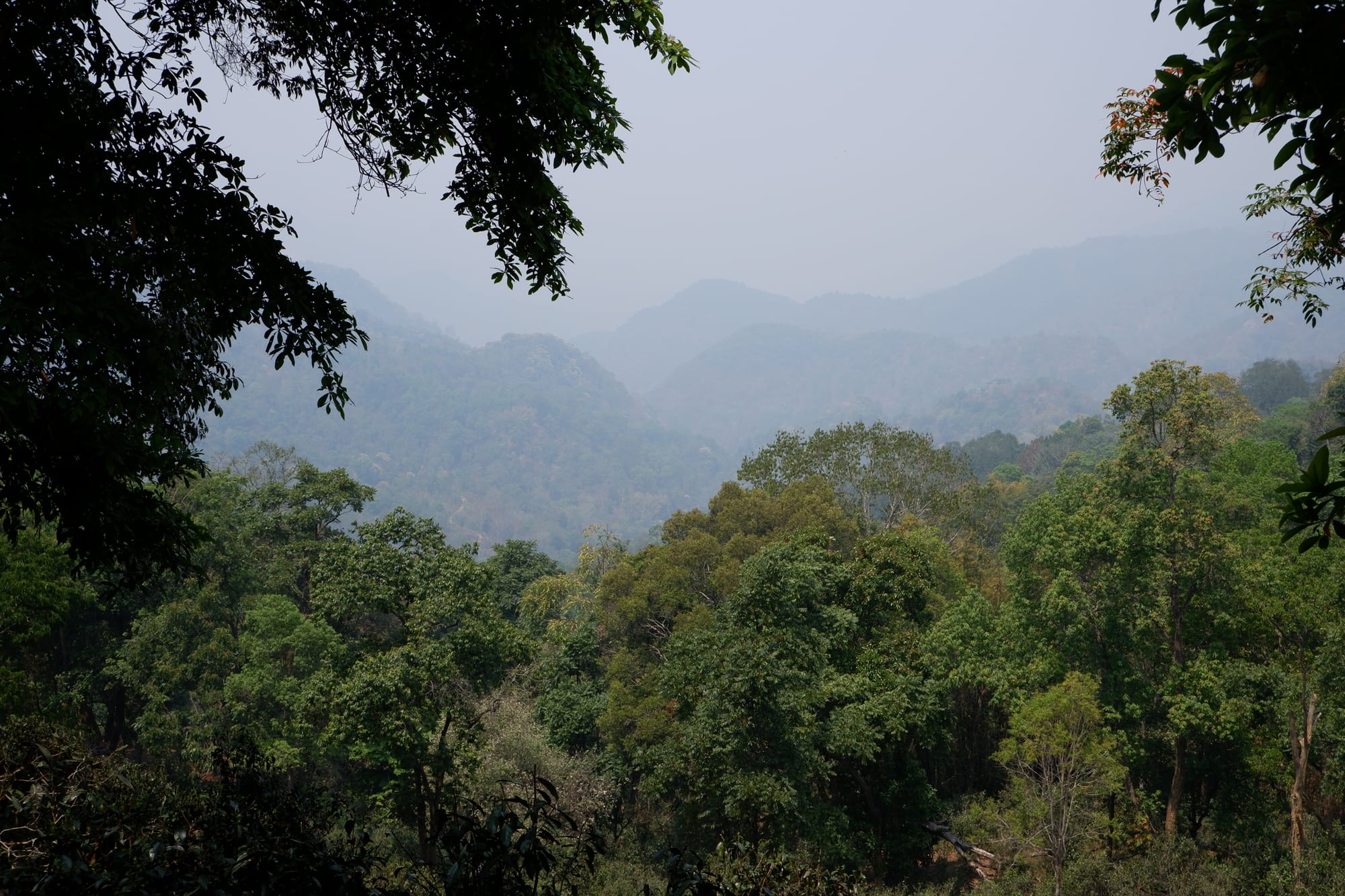
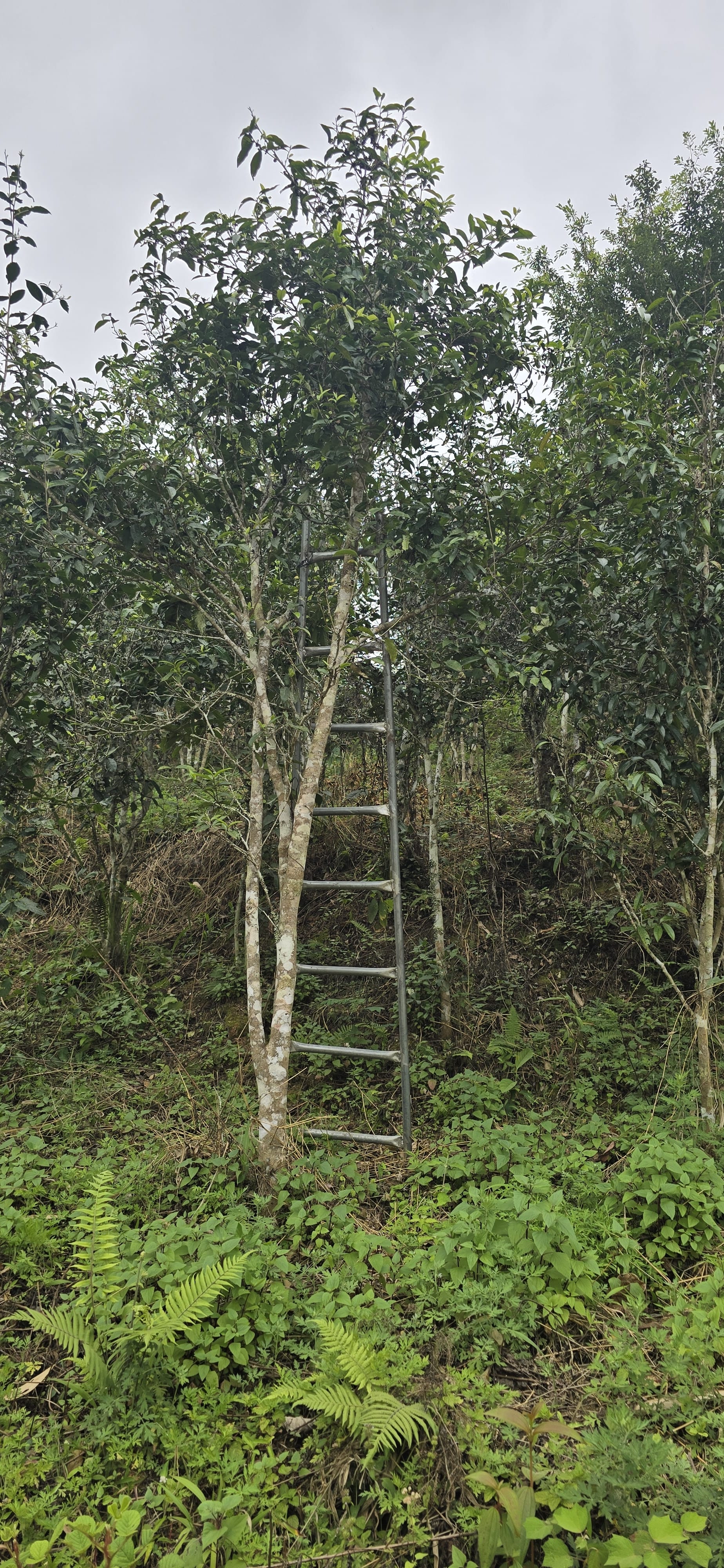
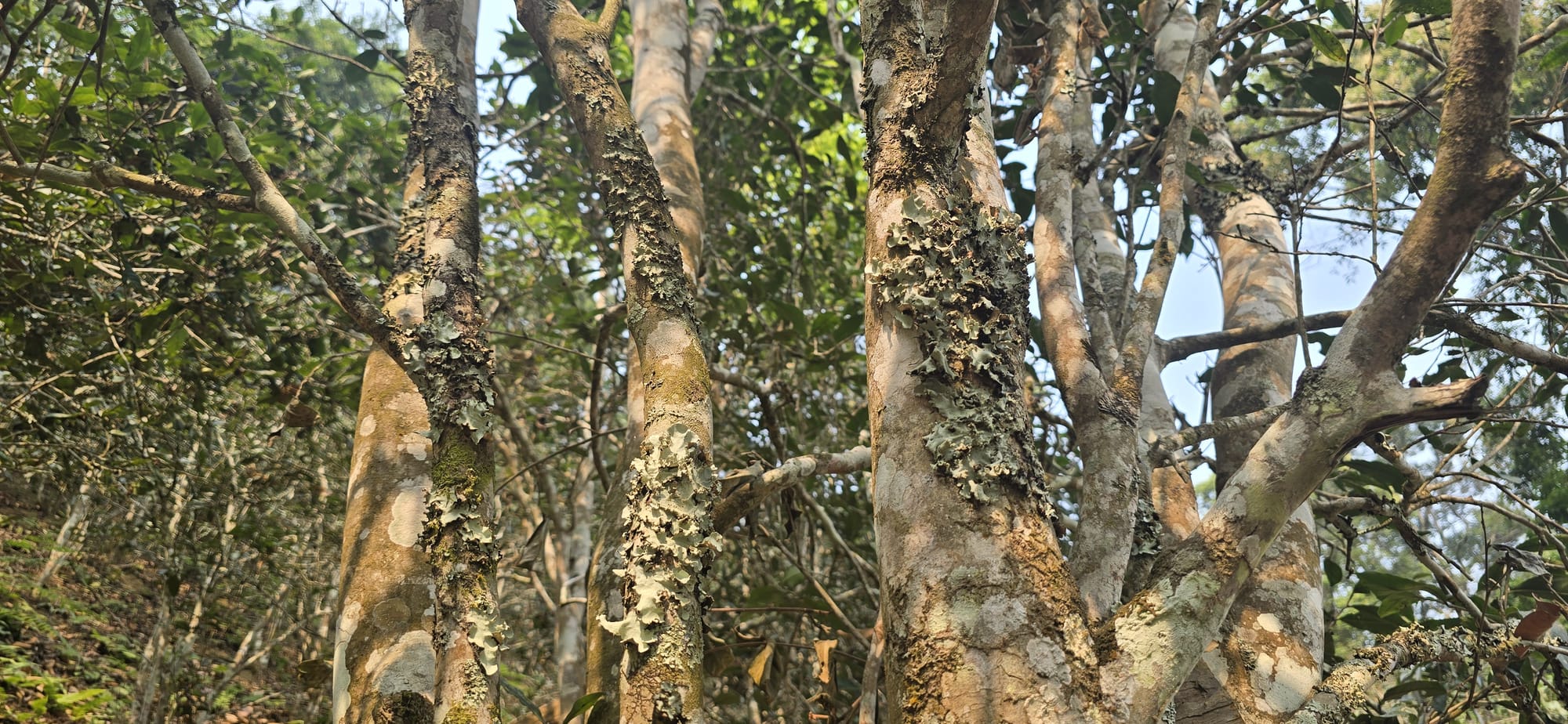
The view from the deep forest, mountains receding into the distance; a tall gaogan tea tree in a clearing; moss on a gushu tree. The sound of insects reverberated throughout the forest, as birds chirped and flittered from tree to tree. This is a healthy forest environment.
Yiwu’s gushu acreage is large, and while its annual tea production is dwarfed by other areas (due to size, tree density, and tree yield), few tea growing regions have Yiwu’s complex mountain topography, with multiple mountain ridges, rivers, and valleys that together create unique micro-climates forming a proliferation of sub-regions with unique names and unique flavor-profiles. The whole region is Yiwu, containing the “6 famous tea mountains”, each of which has sub-regions, sub-sub-regions, specific famous gardens, and specific famous trees.
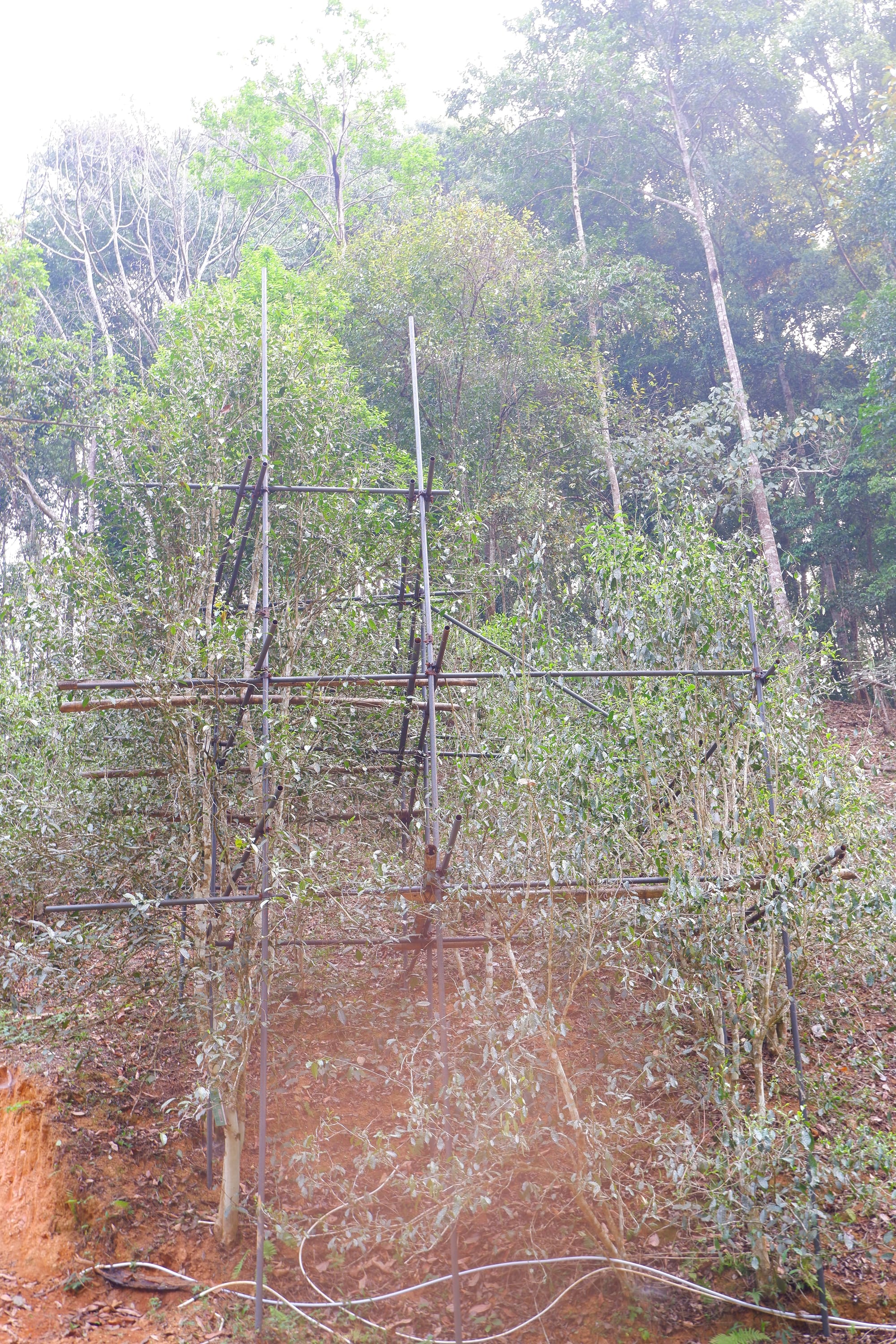
This was an intensive research trip, working with two separate producing families in two different villages. Collectively, the editorial team and I processed over 200kg of sheng pu’er tea, only a small portion of which is ours – the tea making families took one look at our toned physique and put us to work on the wok and rolling trays.
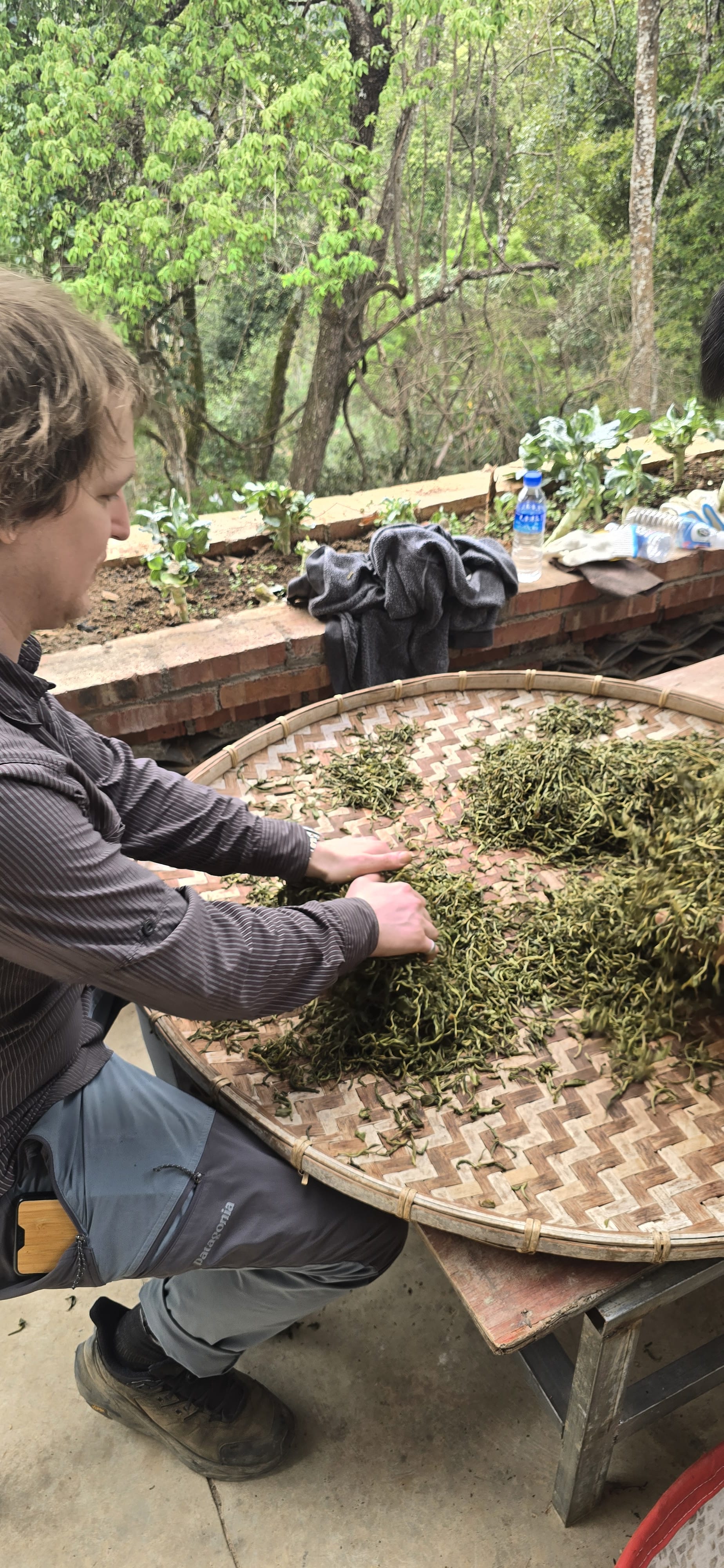
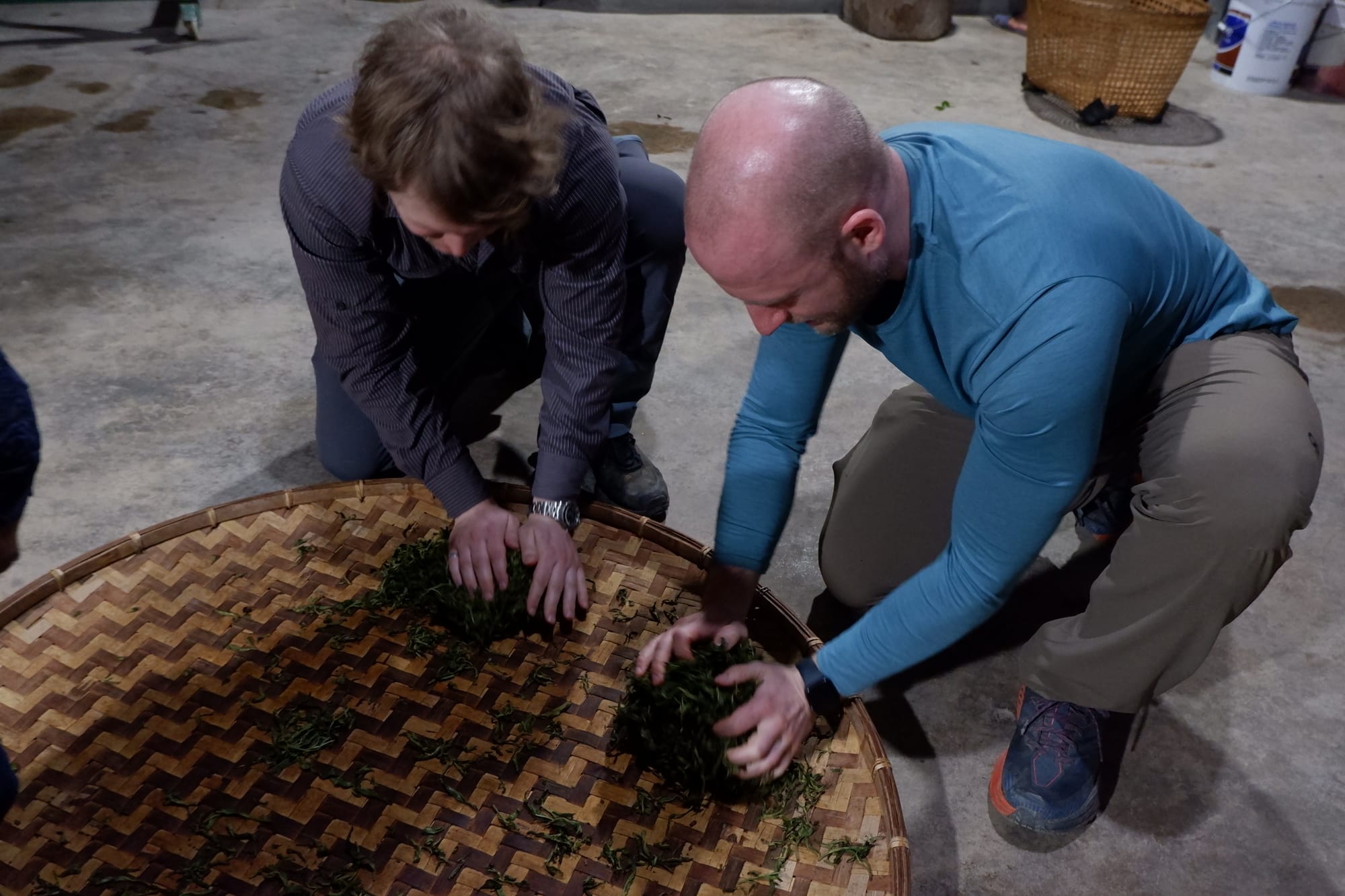
Hand rolling tea (rounian, 揉捻), all day every day.
The steps of “coarse processing” pu’er is relatively simple: wither, shaqing (杀青, “Kill Green”), shape, and dry. The simplicity of the steps hides the nuanced complexity of the process: some families wither extensively and others not at all; stylistic diversity in shaqing methods abound, with variations in the overall level of heat and self-steam the leaves are exposed to; and drying methods likewise contain optionality, including pure sunshine or a covered greenhouse-like outpost often placed on the roof of the village buildings. We experienced the differences from these variations by undertaking our own individual productions of tea – each of us processing a few kilos of our own tea from the same single-garden harvest; we’ve already compared the fresh-process results, and with enough tea to share, the plan is to continue tasting each of our productions over the next few years we spend writing the Pu’er book. Tasting the tea fresh, there were clear differences in our outcomes; those differences are expected to fade over time, with our tea converging on its natural flavor after a decade or so of aging. The implications of a tea, without processing error, aging into its natural state independent of its processing is an interesting thought – counterbalancing the importance of the maker with the predestined natural outcome of the leaf’s cultivar and terroir.
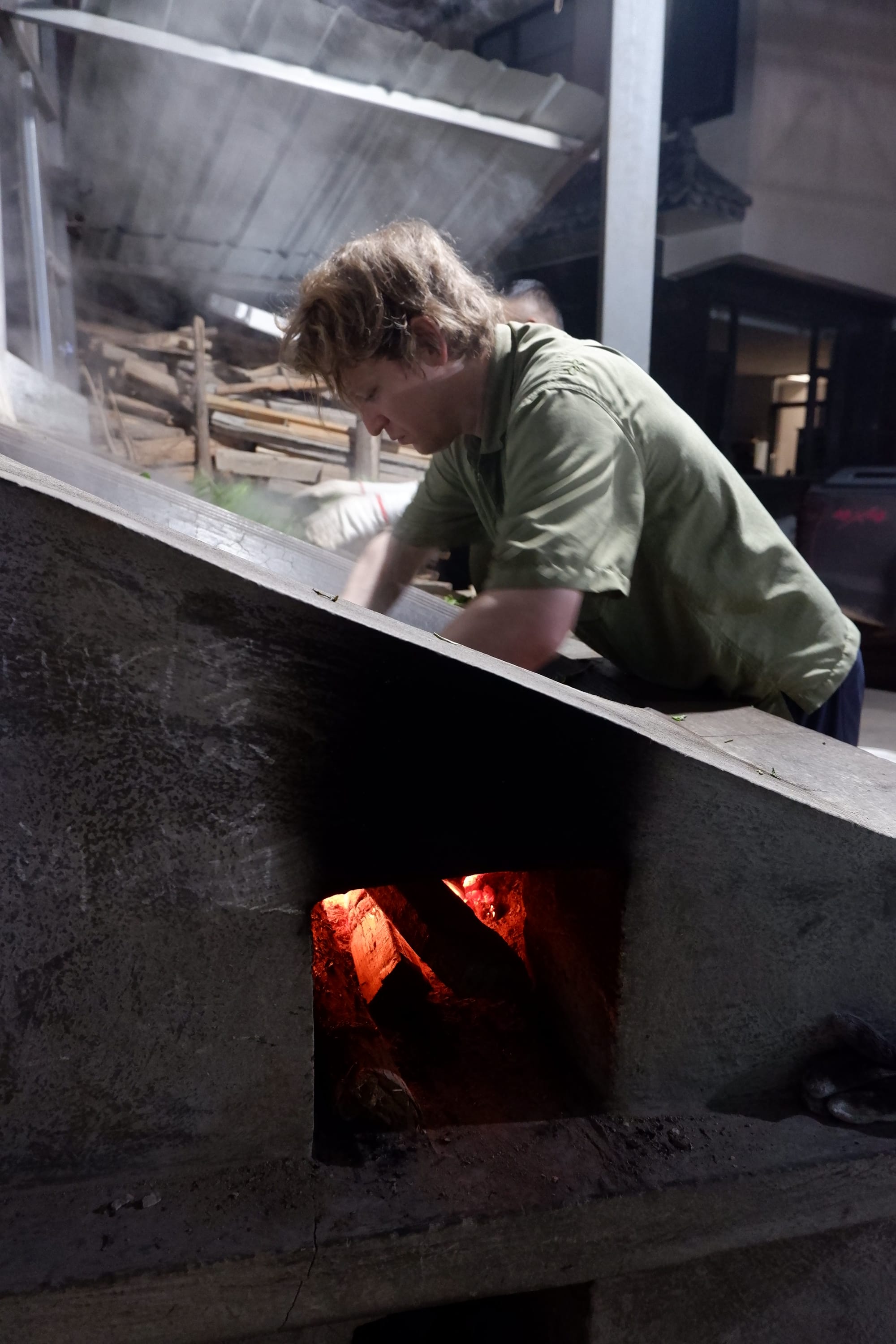
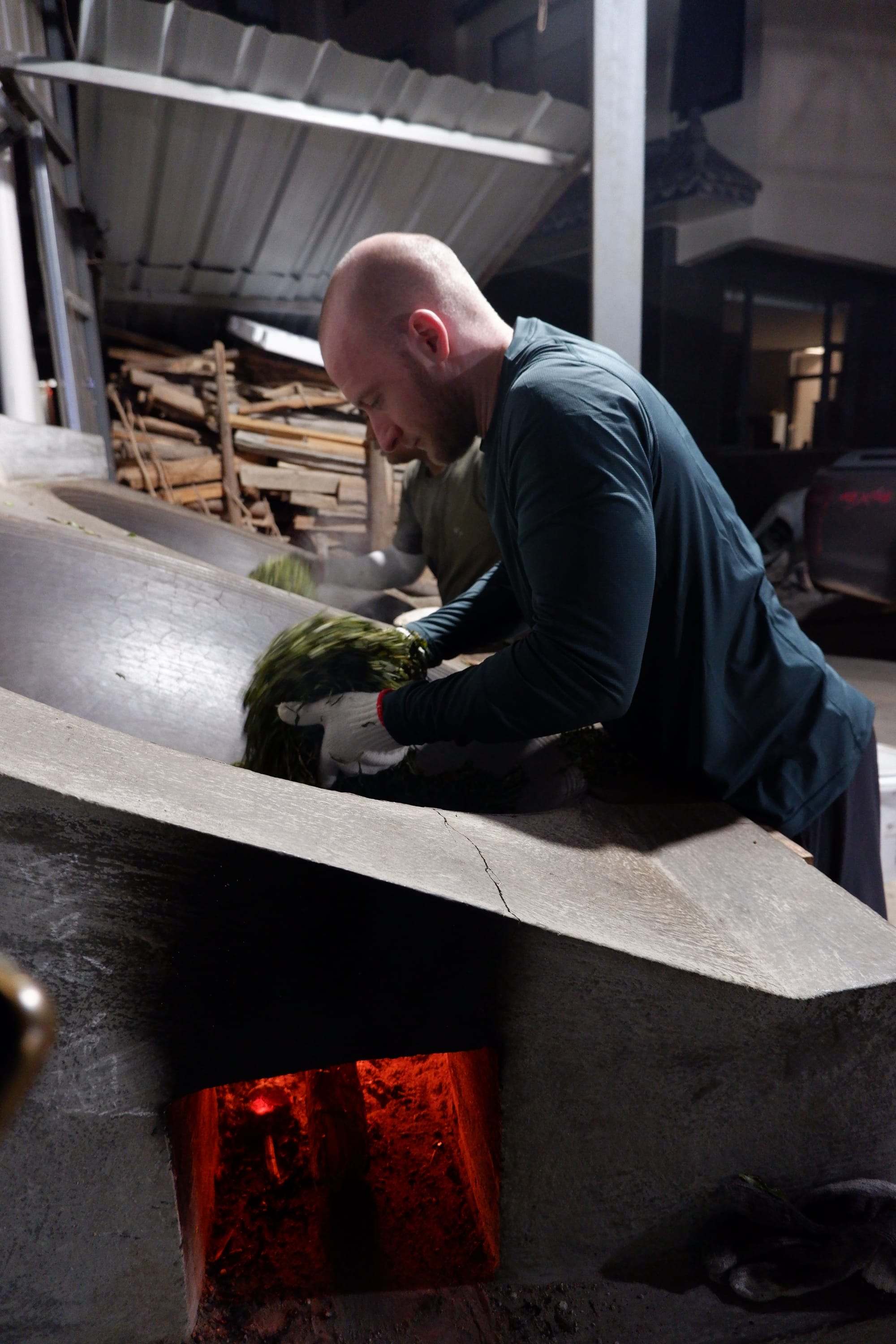
Aura level 10,000 sigma tea chads Jason and Pat competing for eternal glory, Yiwu sheng pu’er shaqing, only the best gushu.
Tea production for us generally happened in the late evening after dinner, when the collected forest tea had been brought back to the village and withered; there were some days with mid-day delivery of tea from closer gardens, and some days with no tea at all, since we were there early in the season, waiting for the precious buds to mature. During the day, we kept busy as well, tasting the fresh harvest tea and venturing to far flung forest gardens branching off from remote villages. Luck was with us this year, holding the rains to optimal times interspersed with intense sunshine (a far call from our experience in Wuyi). We ventured as far as Yibang, always tasting tea from the regions we visited, often alongside the raw leaf right off the tree. Raw tea is not exactly pleasant to eat, though healthy gushu is notably sweeter with a nicer aftertaste than xiaoshu and plantation trees. Bitterness varies more with region than tree age.
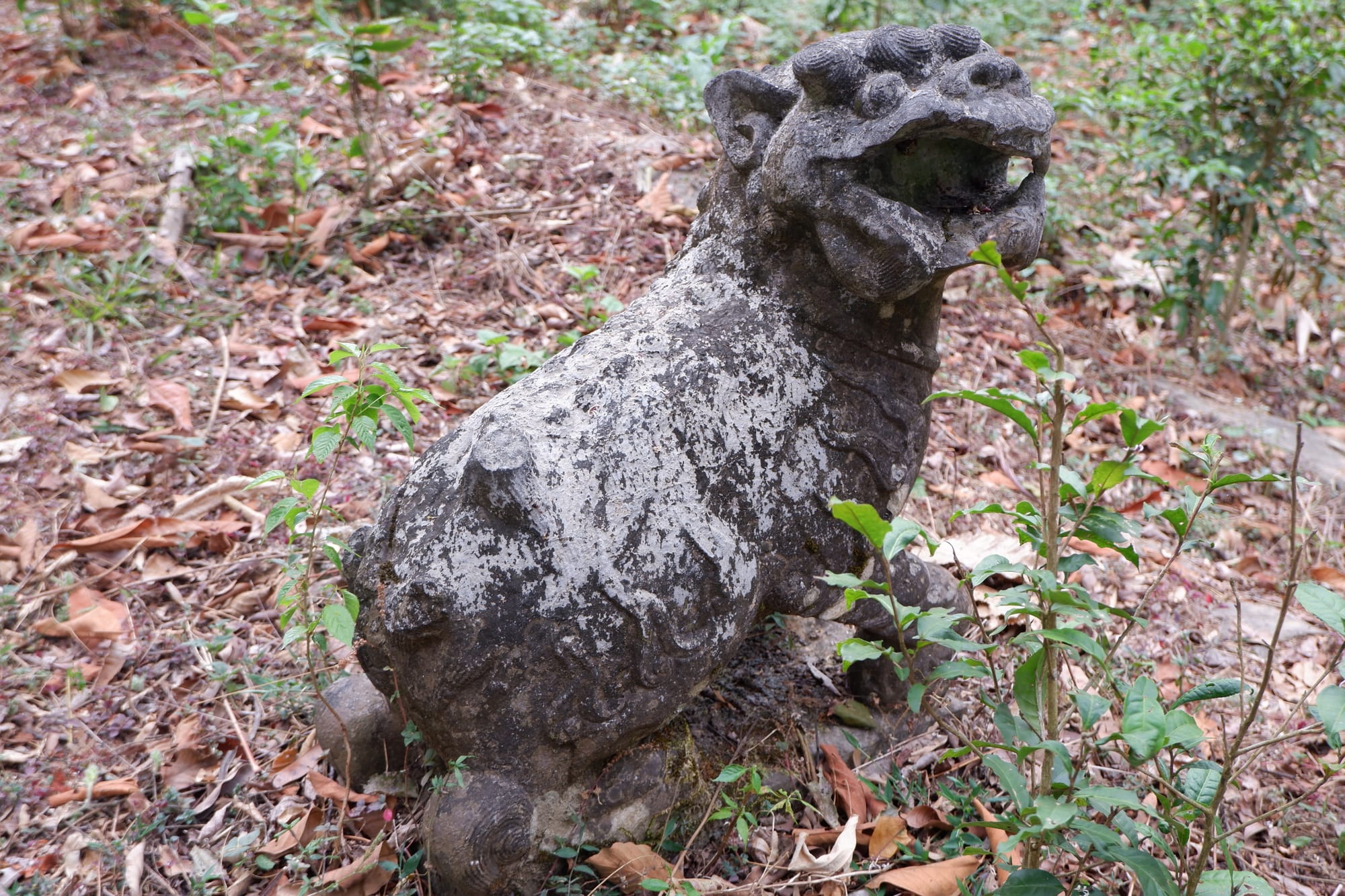
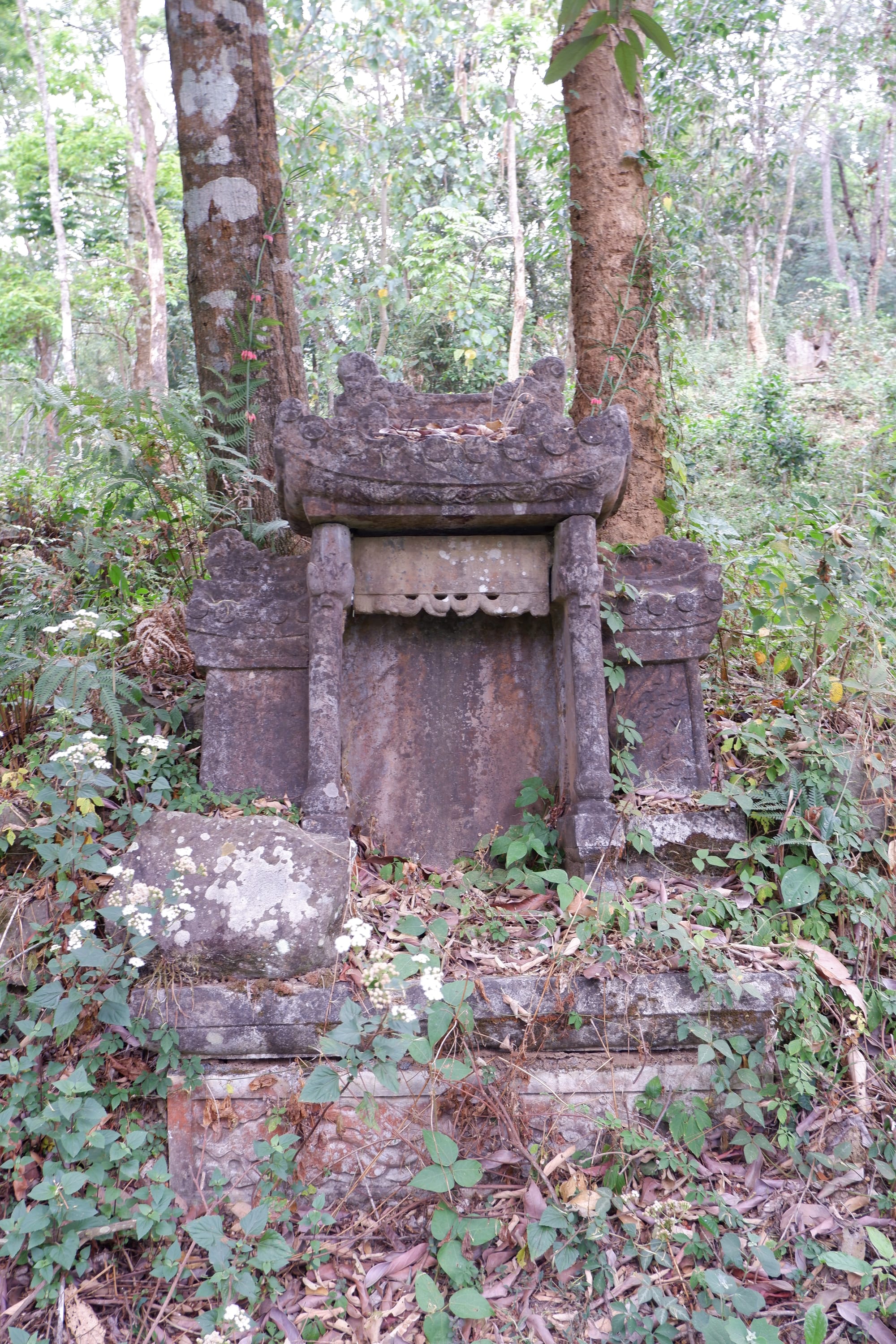
The Tomb of the Lord (土司, tu si) of six famous tea mountains, Cao Dangzhai 曹当斋1773 CE. Sitting in Guanfen Liangzi (官坟梁子) in Yibang. His tomb is surrounded by a mix of gushu and xiaoshu tee.
The western tea market is years behind the conversation in Yiwu, amongst tea makers and high-end tea buyers. While the western market has returned to the very-much-alive horse-to-be-beaten debate on factory tea versus what passes for “single origin tea”, tea at origin is designated as blended, single garden, select trees (or select pick), tall tree, and danzhu (单株, “single tree”). The phrase “one mountain, one taste” (一山一味) has been taken to its logical extreme: each garden on the mountain has a unique taste, the better trees within that garden have a unique taste, and the best gushu tall trees have perhaps the best taste of all, worthy of single tree production. I will leave it to my readers to decide if I move amongst the top practicing tea-circles, and if all my cocktail party jet-set western friends are representative enough to draw any conclusions, but: I don’t see a lot of (forest gushu) gaogan danzhu at western tea tables. Nor do I hear it discussed.
In both the Western and Chinese markets, these terms are subject to varying definitions as terminology is abused for marketing. For example, “gaogan” originally only applied to gushu trees, the ~100+ year old trees that grew tall from the forest environment and lack of human intervention; the term is now commonly abused to sell “dashu gaogan”, which is just “dashu”. Definitions modified for marketing often contradict the plain language definition of the words… some “danzhu” teas are now blends of a 2 or 3 “gaogan” trees (note that this is not a judgment of the results, only a reflection on the shifting definition of these modern terms in their recent history – some single tree danzhu productions would likely benefit from blending with a few other tall trees). Caveat emptor.
Factory teas are persona non grata in Yiwu, even amongst the families doing rough processing for the factories. The production style is distinct and invariably disfavored by Yiwu tea makers, who all produce their own tea separate from their factory work. There exists various levels of agreement with the standard claims used to promote factory tea in the west, including: factory tea is a blend so the flavor is more consistent, young factory tea tastes bitter and strong so that there is enough flavor to age, that factory tea ages better, that factory tea is easier to store (doesn’t require a pu’midor), etc. The concessions we were able to elicit on factory tea was only that the processing style (more withered, less time in shaqing, heavier rolling) yields a tea that changes faster with age.
Now, will some keyboard warrior yearning for gacha points in internet battle whip out their copy of Ancient Caravans, Urban Chic (still recommended!) and quote the dispreference for aged tea in Yiwu as evidence against taking the tea makers’ opinion on aging as gospel (“achshually, you should know, they don’t drink aged tea in Yiwu, you need a more humid environment to age tea”)? Please – allow me to preclude that: Dr Zhang’s excellent book was published in 2013 from fieldwork undertaken in 2007 covering the pu’er boom that started in the early 2000’s. In the ~12 years since publication and ~18 years from the start of her research, a lot has changed. First, the tea makers now have at least two decades of experience with aged tea (both their own tea from aging stockpiles, and from tasting samples or references with buyers); and secondly, have you been to Yiwu? The critique about dry storage was centered on Kunming where many of the tea traders lived because there was so little infrastructure and development in Yiwu (and Pu’er town and Jinghong) in 2013 – Yiwu itself is hot and humid, quite fine for aging tea.
Factory teas have long had a very low rotation in my lineup, and even amongst the factory teas I do drink, they tend to be special productions with good amounts of age. Multiple factors have played into this specific preference development, the two most prominent of which are that my original teachers in Yunnan were themselves tea makers for their own small brands and my early teachers from Taiwan were focused on the boutique production favored by collectors – or very old factory cakes. That said, I don’t avoid factory tea, and with the recent decline in price of the major recipe cakes, Pat and I did split a decently priced not-too-aged cake for comparison purposes and found it to be quite drinkable. In talking to the tea farmers who supply tea to the factories, I was also happily surprised to learn that most of the major recipe cakes contain gushu tea of acceptable quality (though again, gushu is a starting place in Yiwu – the best raw leaf material is going to their own production or high-end commissioned pressings).
In summary: things are different in the mainland pu’er market. Much of the best yiwu tea is never even pressed into cakes – collectors buy the loose tea without packaging or a label. A single danzhu flush might be less than a tong, so what’s the point of pressing? This is a world away from debates about how to age your dayi.
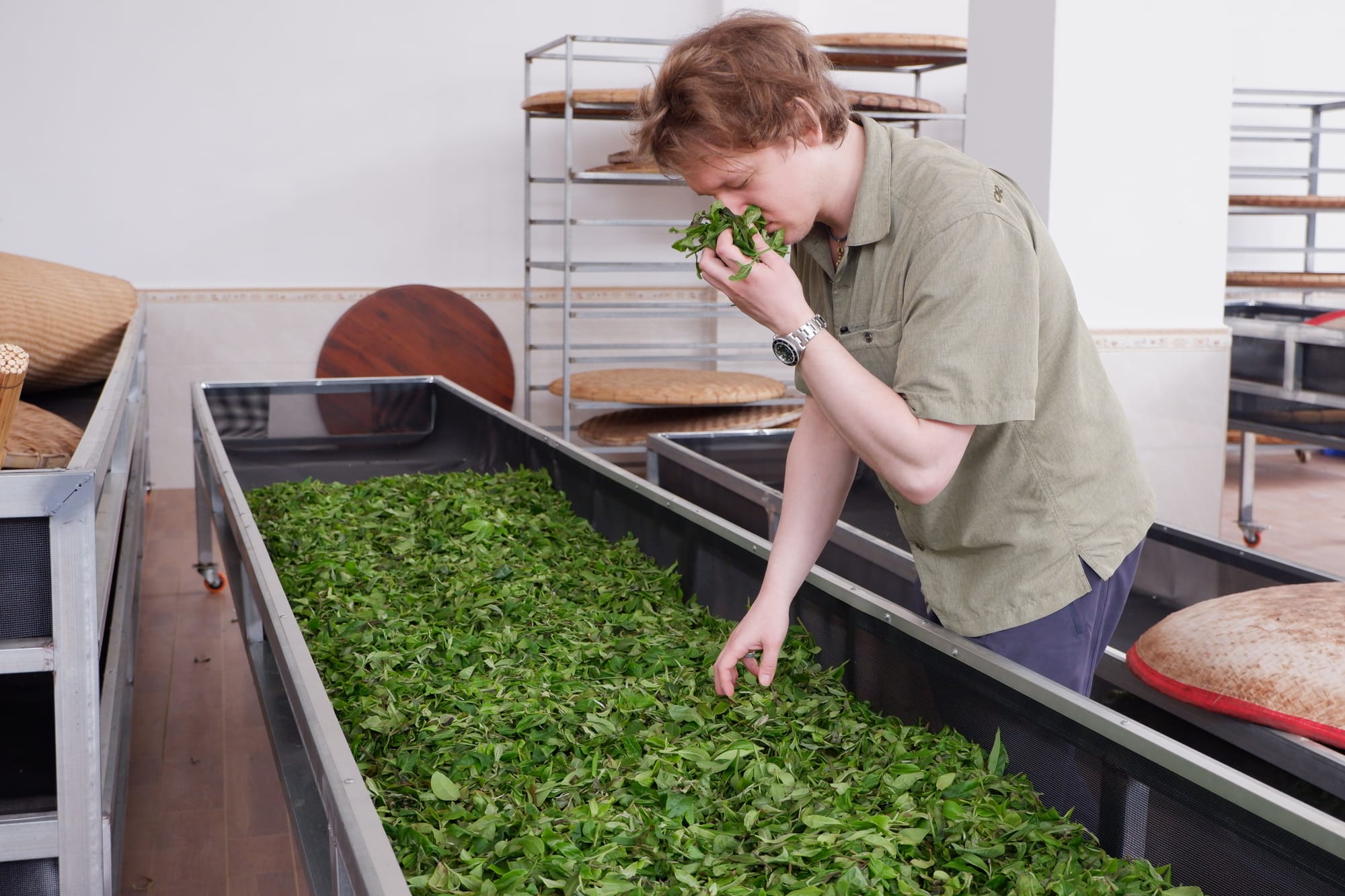
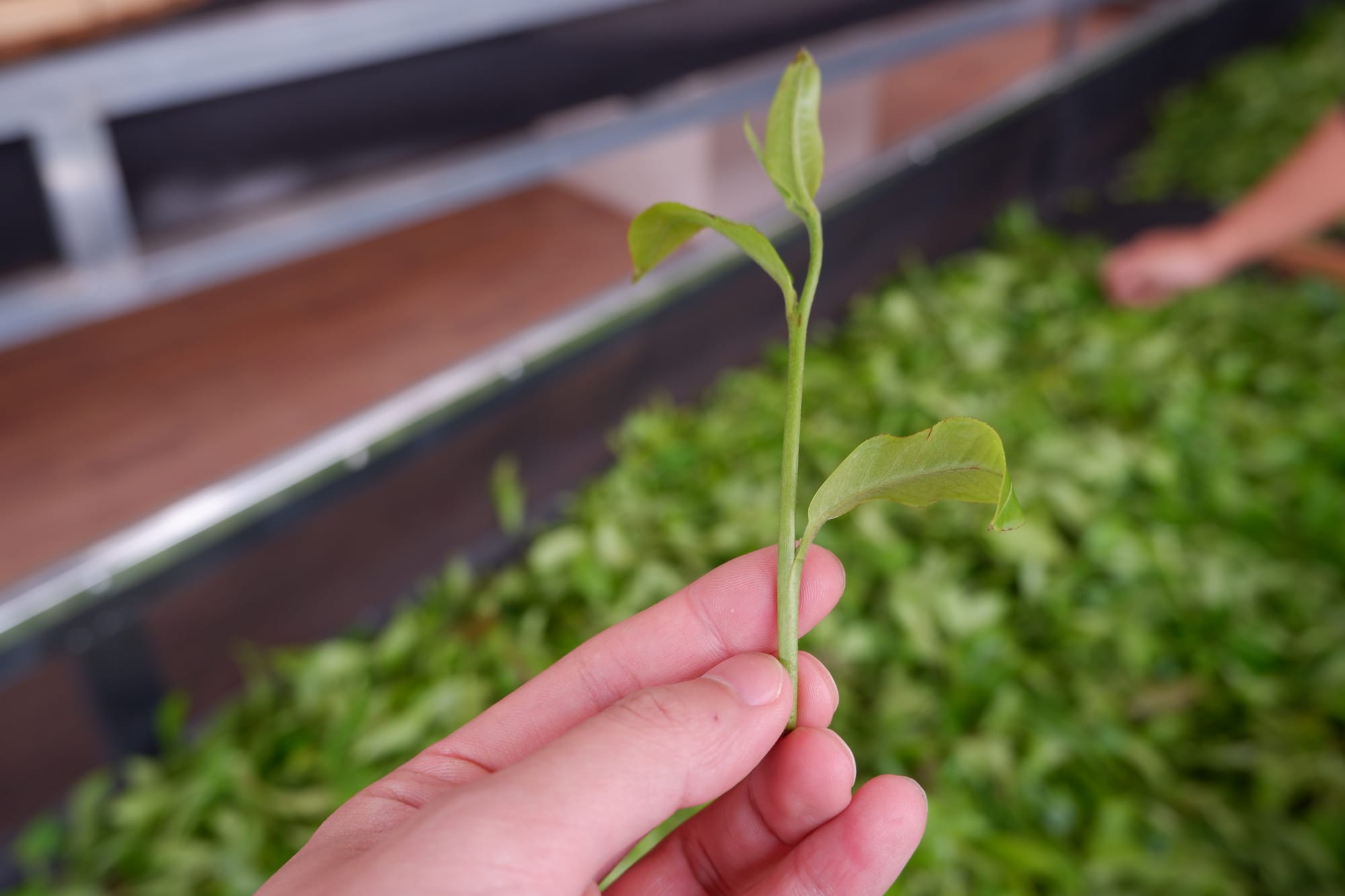
Withering gushu, the long stems are indicative of Yiwu forest tea.
Perhaps my biggest takeaway from this research trip was the intensive wine-like focus on terroir. Discussion about terroir colored almost every conversation we had with farmers, makers, buyers, and sellers alike, to an extent beyond what I had experienced before this trip. Preferences for and against specific areas were openly stated, though often with exceptions, for areas outside of Yiwu: “I don’t like Lincang tea… except for Bingdao” or “I don’t like Jingmai teas… except for Dapingzhang”. Within Yiwu, the focus on micro-terroir was entrenched in extremis. Someone might say “I like Gaoshan village tea” and another might reply “yes, but only Bajiaolin” (the forest stretching from the south-west to the north-west side of Gaoshan mountain), to which someone else might reply “I don’t… even Bajiaolin has that Gaoshanzhai astringency”, to which you as a learned and wise and active participant in this conversation could conceivably reply after years of careful study in the nuances of Yiwu pu’er “most, but of course not all – the mid-mountain gushu select-picks from the furthest north-western Bajiaolin gardens have a more floral-orchid and herbal lemon-balm note, and the best pickings develop an almost ethereal fruity note, more similar to Walong” to which everyone will nod and smile and make a mental note to re-taste their Bajiaolin north-western mid-mountain gushu against a walong tea, hopefully in order to re-evaluate their own notions of the flavor-gradient between the not-quite-adjacent regions, but really more likely to re-evaluate the esteem in which they hold your opinions.
I found these discussions of distinctions not dissimilar to the French Appellation d'origine contrôlée used in wine, where adjacent vineyards mere yards apart may be ranked differently and sell for hundreds of dollars more or less per bottle (retail not restaurant, this isn’t starter wine; you’re not purchasing wine off random menus are you?). Such is the case in Côte-Rôtie (though note that all wines in Côte-Rôtie proper are cru, without further sub-division in AOC ranking to help you muddle your way through a wine list), where the wine grows in neat rows on a steep south facing bluff by the river.
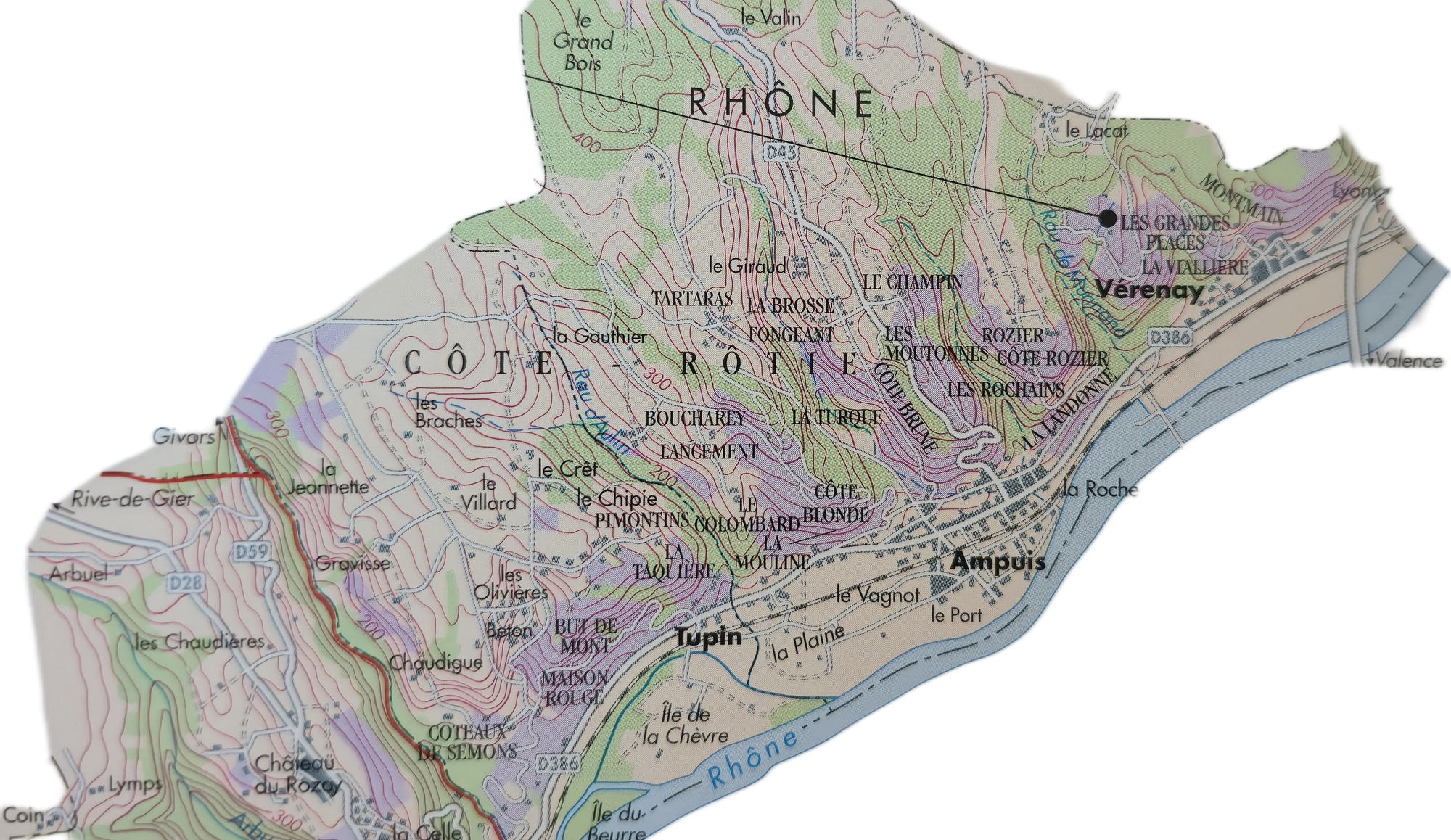
Each slope, varying in soil and sunlight creates a unique micro-terroir, causing rather drastic changes in flavor profile to a discerning palate, all from the same Syrah grape varietal (and up to 20% Viognier white grapes; think of this like purple leaf sneaking its way into your gushu). The high concentration of micro-terroirs in a small region growing the same grape allows one to taste the impact of the sun and soil, naturally leading to a parallel debate on which vines produce the best wines and my oft repeated aphoristic advice “leave the Blonde for the blonds, get loaded on Landonne”, which applies only to Rostaing of course. IYKYK, if you don’t know, ask your butler or nearest M3S sommelier to arrange you a tasting, the results are relevantly revelatory.
In any case, while I had preferences around the expected flavor-profiles of specific pu’er producing regions such as Jingmai and Banzhang and Yiwu, the extent to which flavor-profiles are attributed to micro-terroir and the identifiability of a micro-terroir’s attributes was new to me, forming a major component of the learning for this research trip.
Similarly, I was surprised to find that what I previously called the gushu “Guoyoulin flavor” (国有林风味), that intense forest-gamy, slightly-bitter-woody and occasionally medicinal profile, to be controversial amongst the local tea farmers and tea makers. While I knew that the profile was only found in large gushu trees, we learned during this trip that the flavor is indicative of “big tree”, in the wild-type sense of the term. Preferences for and against this profile were divided family by family, such that some families believed that profile to be an indicator of quality produced only by large deep forest trees and thus rare and good, while others believed the profile to indicate an impure strain either descendent from or hybridized with wild tea. There is today a complex intersection of research, myth, local beliefs, evidence, and counter-evidence on the differences between cultivated and “wild tea”, encompassing a range of what might be considered wild, potentially including or excluding yesheng varieties; the truth of the matter won’t be resolved in this trip report – you’ll need to wait a few years for the eventual book – but it is important to note that the debate is not purely academic: different farmers, makers, merchants, and collectors are selecting or avoiding specific profiles based on facts or myths about wild tea.
In my case, while I came to Yiwu with a non-exclusive preference for that flavor and thought of it as an indicator of quality, I understand why others believe that profile should be avoided – Yiwu tea is known for its sweetness, its softness, its refined and balanced profile, enjoyable even when very fresh. The “guoyoulin” profile is not that, and before this research (despite having been in Yiwu previously) I had not experienced certain families attempting to preserve and promote an overall flavor profile for Yiwu.
Furthermore, after such a long discussion on the importance of micro-terroir, it should be noted that the profile under discussion is actually rooted in variations in tea-varietal; the profile is associated with the guoyoulin, where many of the largest trees grow – yet the guoyoulin is a huge area comprised of many sub-regions each with its own micro-terroirs producing a range of profiles. Much of the tea from guoyoulin, even the furthest villages such as Guafengzhai which are often known for their so-called “wild-type” profiles, produce great tea within the softer Yiwu flavor-space.

I don’t yet have a solid judgment on this, and my collection contains many cakes of both types. I still personally enjoy much of the “wild-type” previously-termed “guoyoulin profile” sheng, though I am now re-tasting to see if there is a consistent negative body-feel (qi) as some anti-wild-type families claim. I also remain skeptical of the current received wisdom on what is and is not wild tea, and the horticultural and genetic progression of tea’s domestication. This component of the future book should only take a few years to work out.
All is not well in Yiwu, but after our 2024 Research Trip, I can confirm that we were many steps closer to heaven here than we were in Wuyi. During the pu’er boom, some gushu gardens were converted to plantation style tea within Yiwu proper; nearby, thousands of acres of land in the foothills of Yiwu and unsuitable flatland were also planted in taidicha (台地茶, plantation style flat land tea) fashion. Then, for a short time after the pu’er market crash in 2007 when the world was ending and the future was pu’er-less, tea lands were torn up for planting rubber and banana trees (side note: have you ever seen anyone in China eat a banana? I haven’t, and I wonder where all these bananas are going… Zongjun notes that ~13m tons of bananas are consumed in China every year…). This year, the highway will finally reach into the mountains, cutting through gushu tea gardens and bringing tourists and traffic into the forest. In recent years, there hasn’t been enough rain to sustain historical yield levels (it’s too early to tell, but 2025 may be an exception).
Problems abound for tea farmers and tea makers across China. In the Qing dynasty, tea brought outsiders, money, and wealth into the mountains; land owners planted tea and commodities, changing the natural landscape. In the present day, tea has brought outsiders, money, and wealth into the mountains; land owners planted tea and commodities, changing the natural landscape. Tea is a business. Pu’er is a business.
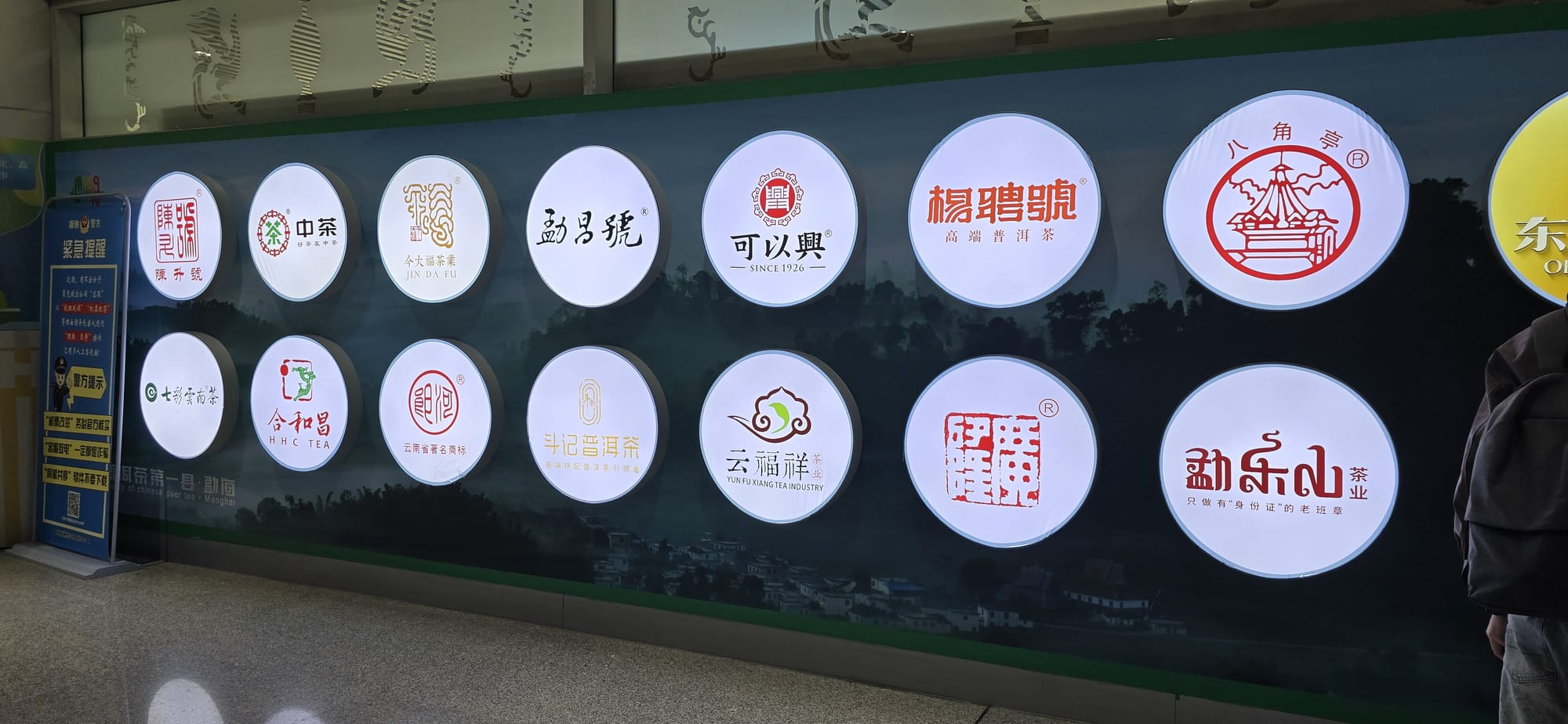
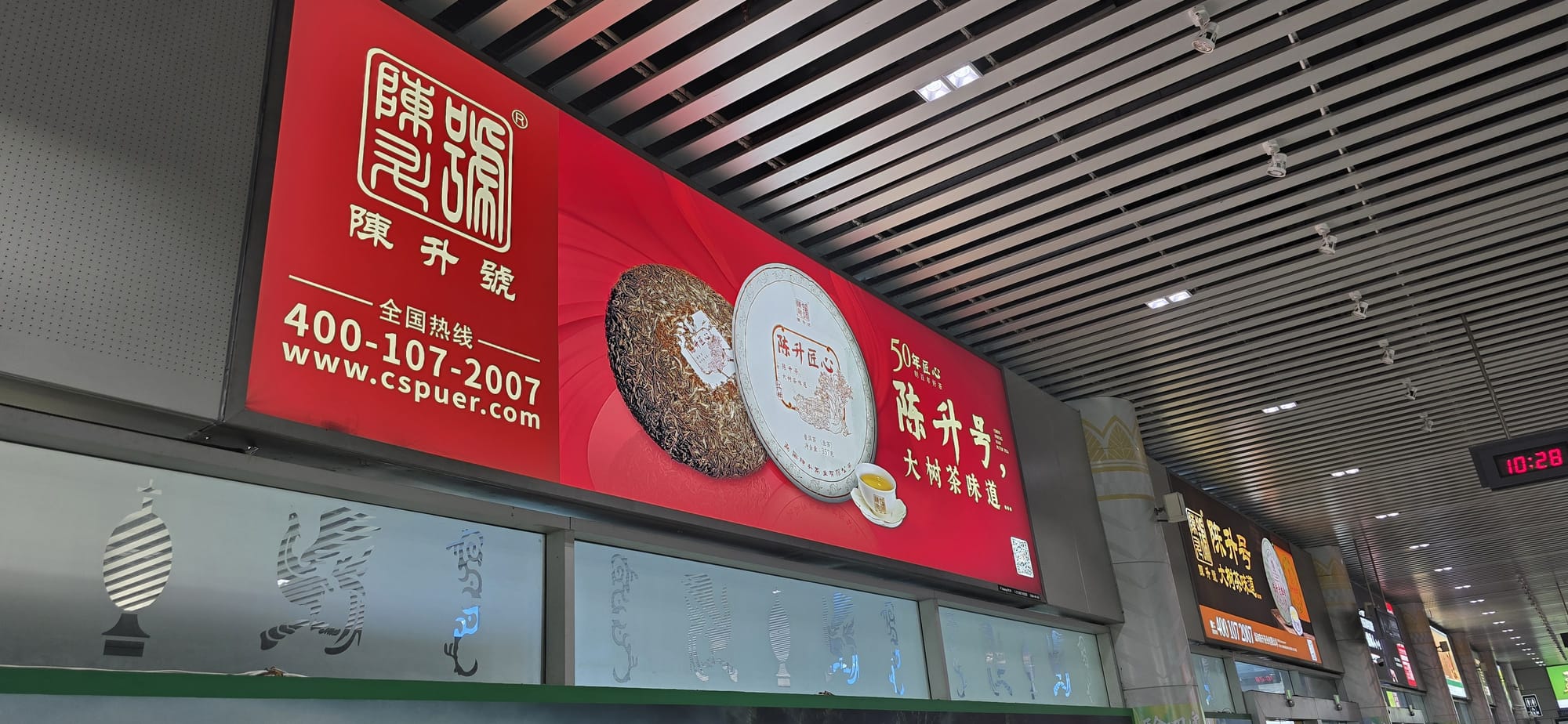
Advertisements for pu’er brands in the Banna airport. It takes more than ancient gushu groves to supply the world with pu’er.
Those in the industry are responding to the current incentive. In a very positive development, the incentive for Yiwu proper is generally aligned toward natural grown gushu tea. The local government has enacted strict rules and monitoring to protect the environment, severely limiting development (with exceptions for infrastructure such as the highway) and village expansion. The local farmers and tea makers understand where their new-found wealth comes from and are more environmentally conscious than average for the country (where there is real work to be done, on things as basic as littering). The forest is healthier in Yiwu than anything we saw in Wuyi or Wudong.
As an example, we looked not just at ancient gushu tea growing wildly in inaccessible slopes of the most famous named gardens – we also took pains to see and understand some of the planted gardens; in many of these, xiaoshu trees grow under a forest canopy in health soil without pesticides or fertilizers. There are certainly a few gardens with tilled soil and new plantings spurred by fertilizer, yet the general sense in Yiwu is that such methods are not needed and not worth the investment with so much better tea in abundance.
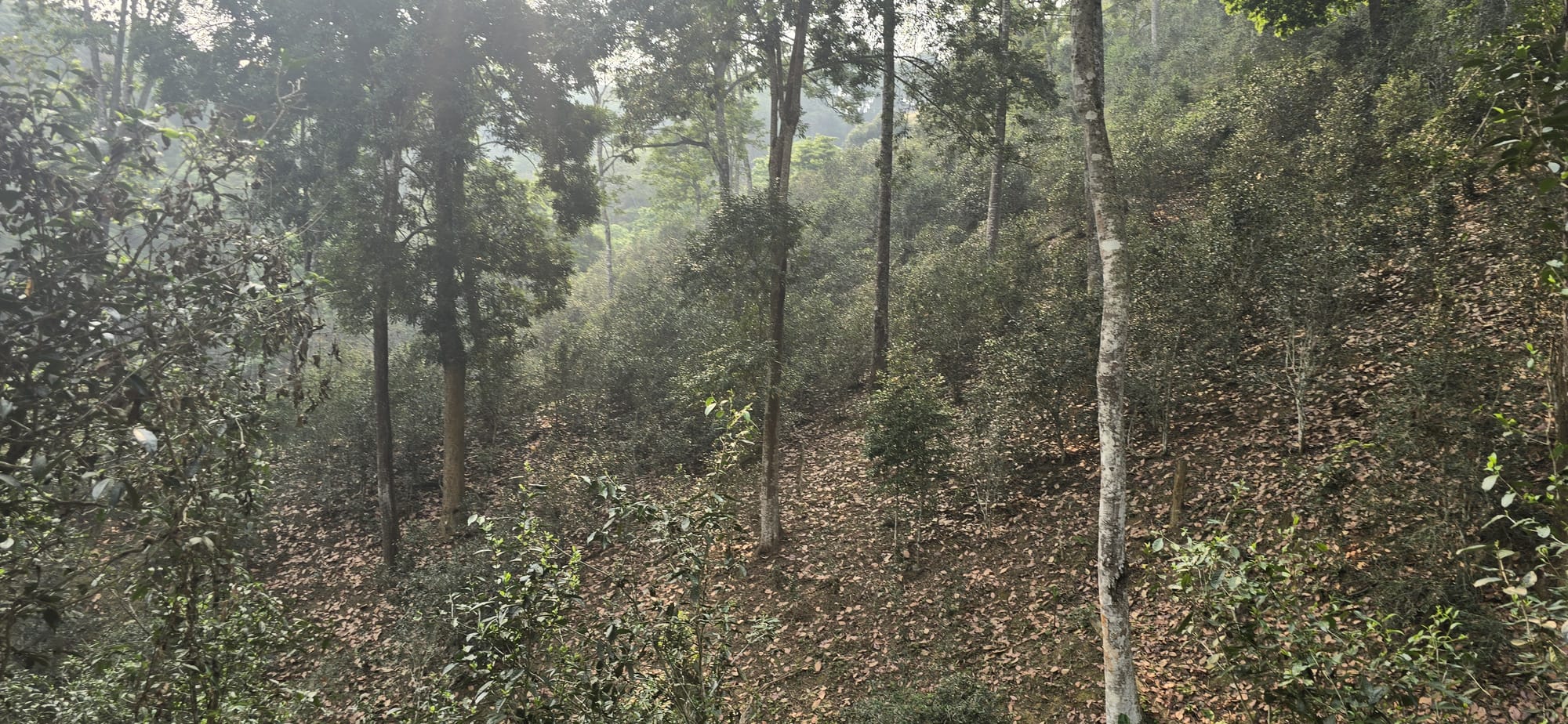
I’ve only just returned home, after a separate foray to Taiwan, so it’s still too soon to know what effects this will have on my tea drinking. Following Chaozhou, I drank a lot more dancong; following Wuyi, I drank a lot more dancong; so if the trend holds, I think some laocong dancong, like a 雷扣柴, might be in order… though I did carry back a few kilos of sheng with more racing the tariffs… certainly some pu’er is in rotation, with a lot more set aside for aging.
More seriously, I think I will be both more selective and more targeted with my purchasing and consumption; the deeper exposure to the conversation in Yiwu leaves me feeling like we’re on the wrong side of the Berlin wall – we get the punk rock indie vibes (Western facing tea brands) made from the meager matériel that makes it out of the East (in this strained metaphor, the West), soon over a new wall of our own construction (tariffs). This is not to dismiss the difficult and necessary work than certain western tea brands labor to do – someone needs to build the Western market! – though it is to say that the market in the west is behind the times in its conversation and preferences. How much East German punk did Berliners listen to after the fall of the wall?
East German Punk!
Migrating through time from the cold war to the trade war, I’ll likely halt my purchases outside of China; the idea of purchasing without sampling is becoming increasingly verboten, and with direct access to tea makers, the information on specific gardens, trees, and flushes allows for a greater level of informed choice. I plan to target my ongoing collection on the necessary material with unique attributes needed for preparatory research on this book. Hopefully that includes a few danzhus. Just a tong per tree will do nicely.
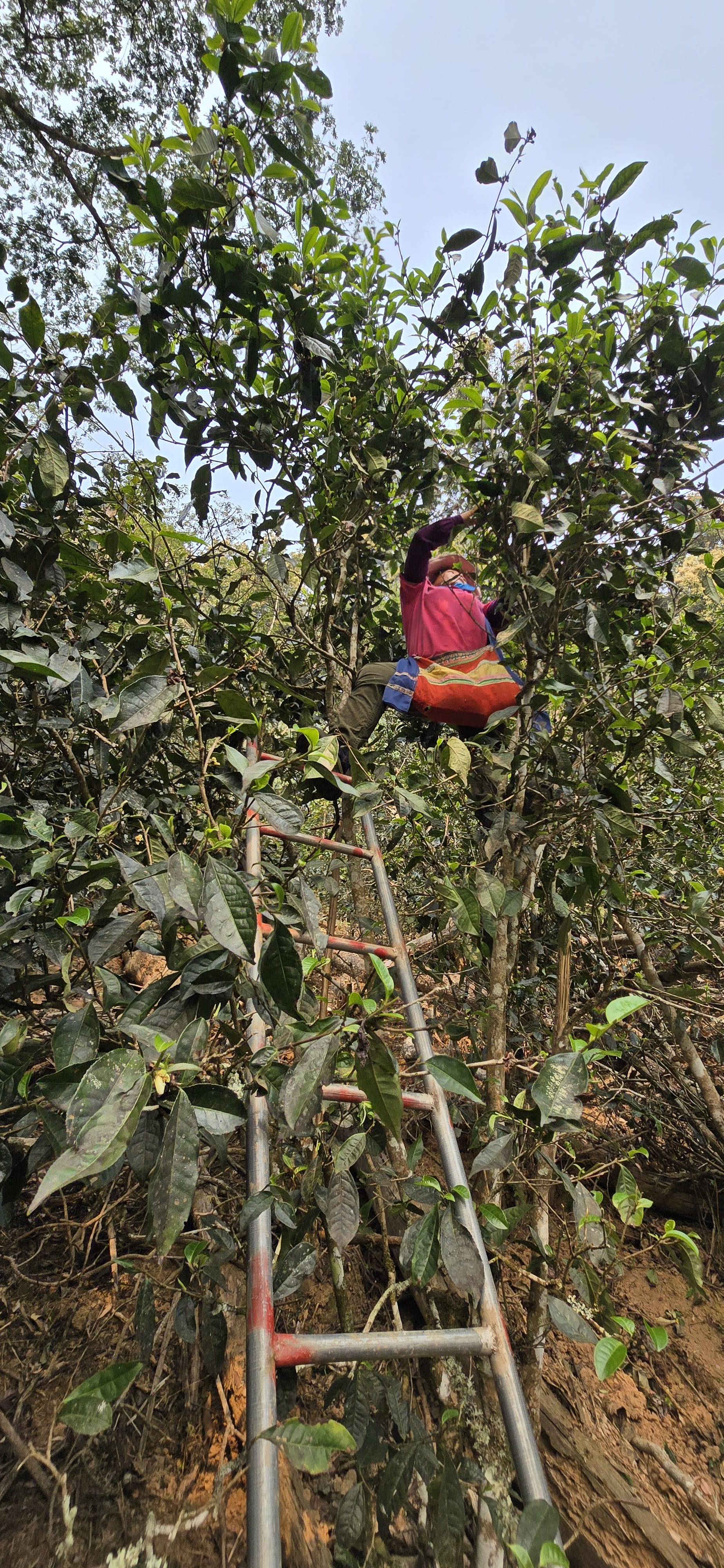
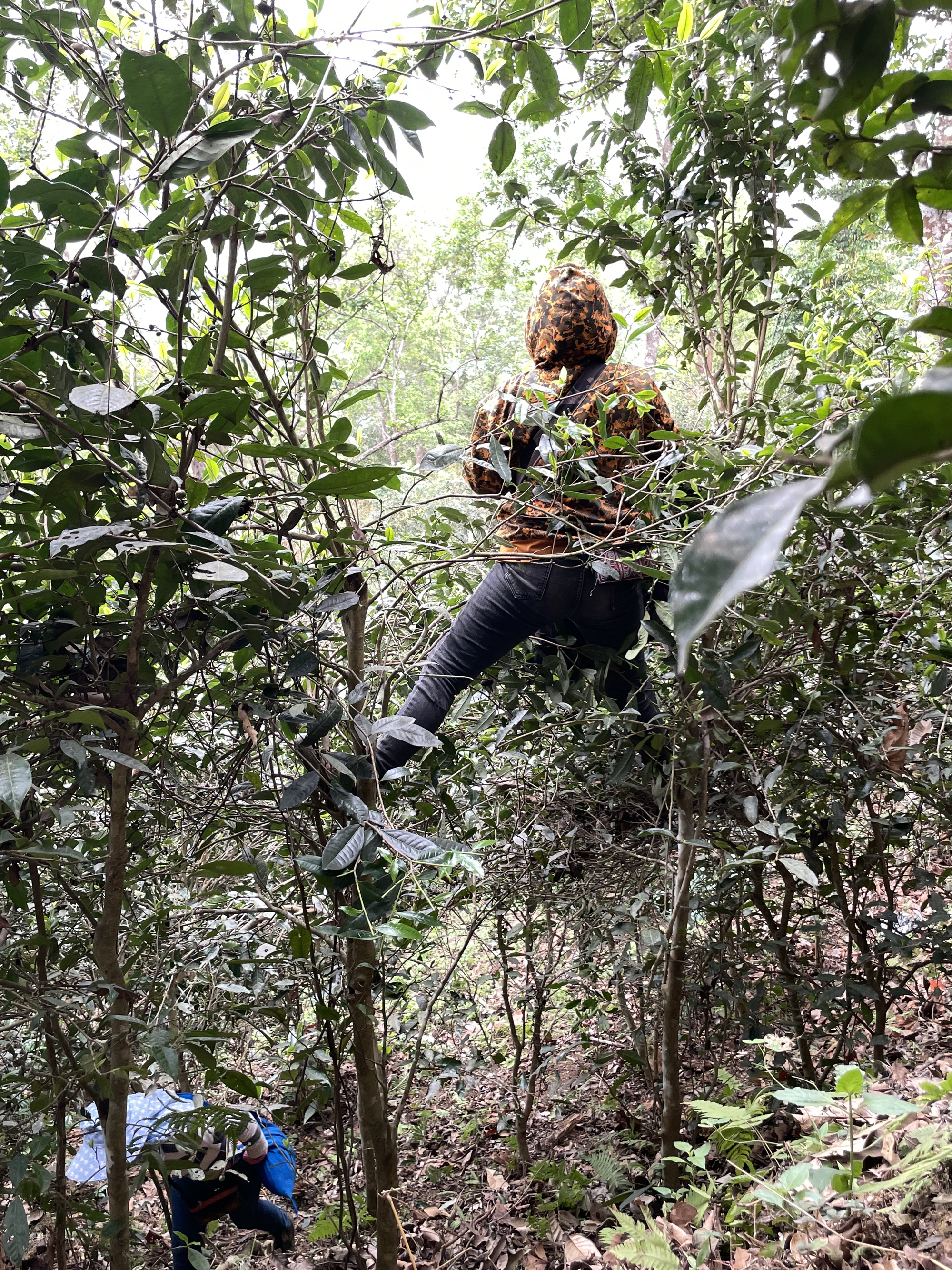
Some pickers need ladders, others go full Crouching Tiger Hidden Dragon. Mad Skillz.
I also plan to drink young Yiwu more often, rather than waiting for my young teas to age – I have enough Sheng to last a lifetime and have spent the last few years mostly consuming my mid-age stash waiting for the younger teas to age and with the older teas reserved for special occasions. With this trip’s finding (and purchased haul), I’ll happily be drinking this year’s harvest with nary a few months rest; infanticide you may cry, but don’t knock the baby juice until you try it.
I’ll end on the outcome of the Tea Technique 2025 Research Trip to Yiwu and our plans for the future: this is going to be a long project. We fully expect to spend the next few years researching pu’er, traveling to every major tea region within Yunnan, making or commissioning a few hundred more kilograms of tea in various experiments, and establishing relationships and collaborations with additional farmers, families, merchants, collectors, and at least one wandering mendicant surviving on wild mushrooms and raw tea leaves in other areas. This portion of the preparatory research is expected to take ~3 – 5 years.
Then we’ll begin the editing and publication process, which is only expected to take another ~3 – 5 years, during which we’ll be enjoying or suffering through the results of those production experiments. So, we’re planning a mere decade of work on this. Maybe east German punk and cheap factory shou will be back in vogue when were done. Given the expected length of this project, there will likely be a shorter book or two on other tea topics published during the research period.
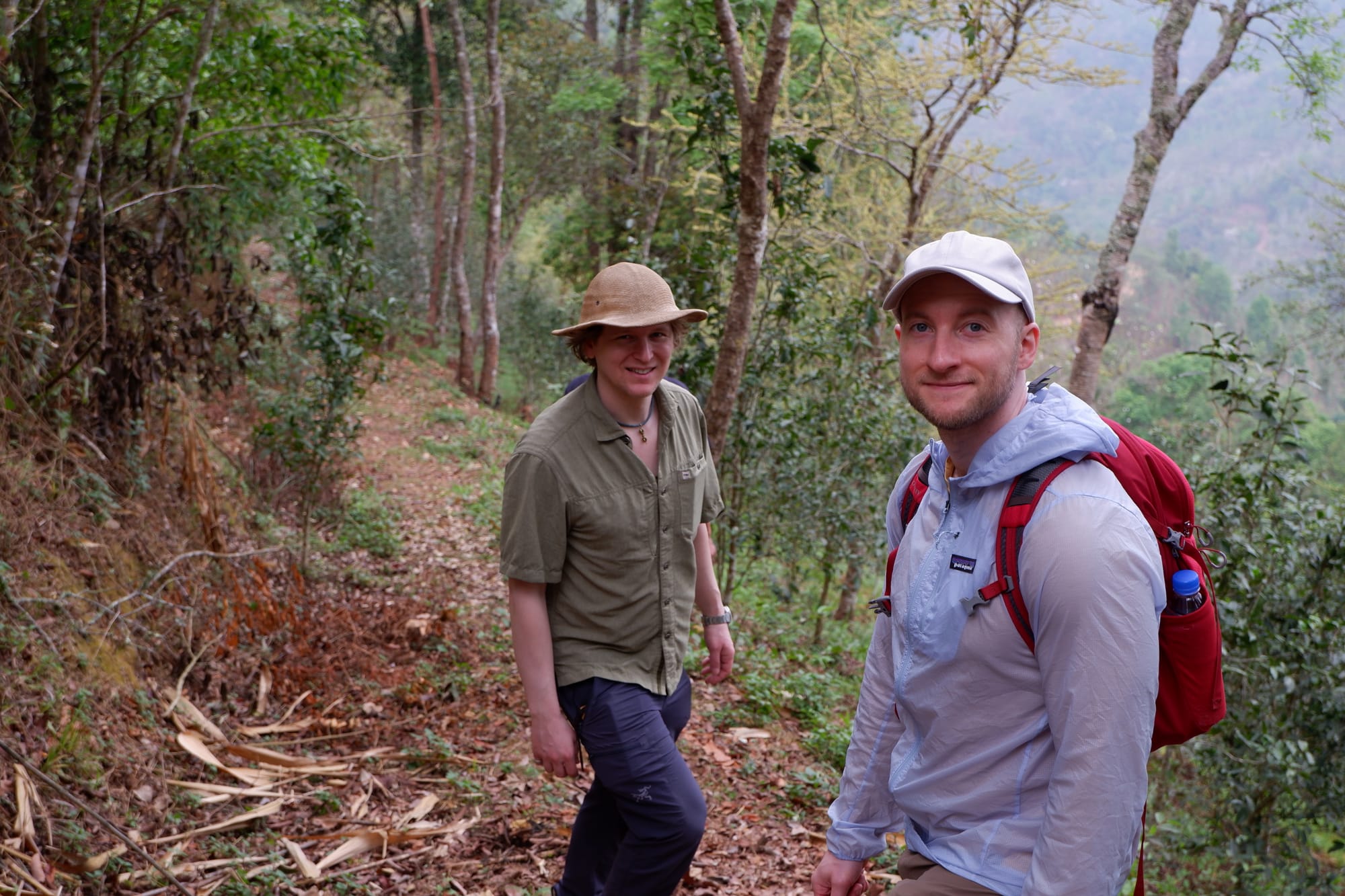
Two paths diverged in a Yiwu wood,
And sorry I could not travel both,
I looked down one as far as I could,
To where a single gaogan stood unbent in the sun,
Then I took a look at the other path, just as fair,
having perhaps the better chance,
Because it was canopy covered with cool air;
And both paths that morning equally called,
With snakes on the ground and bees in the air,
Oh, I kept the first for another day!
Yet knowing how way leads on to way,
I doubted if I should ever come back.
I shall be telling this with a sigh,
Somewhere ages and ages hence:
Two roads diverged in a wood, and I—
I took the one less traveled by,
And that has made all the difference in acquiring single bush danzhu pu’er.
We will be returning to Yiwu, where heaven is close and the emperor far away.